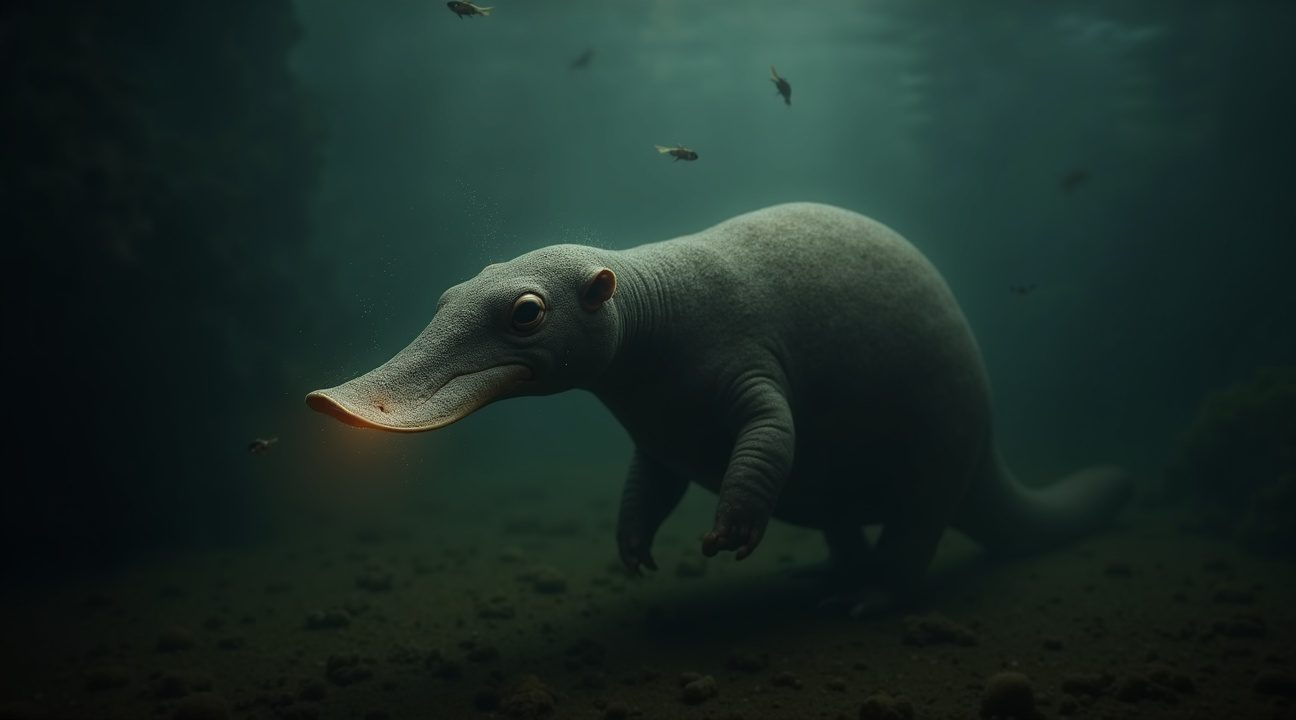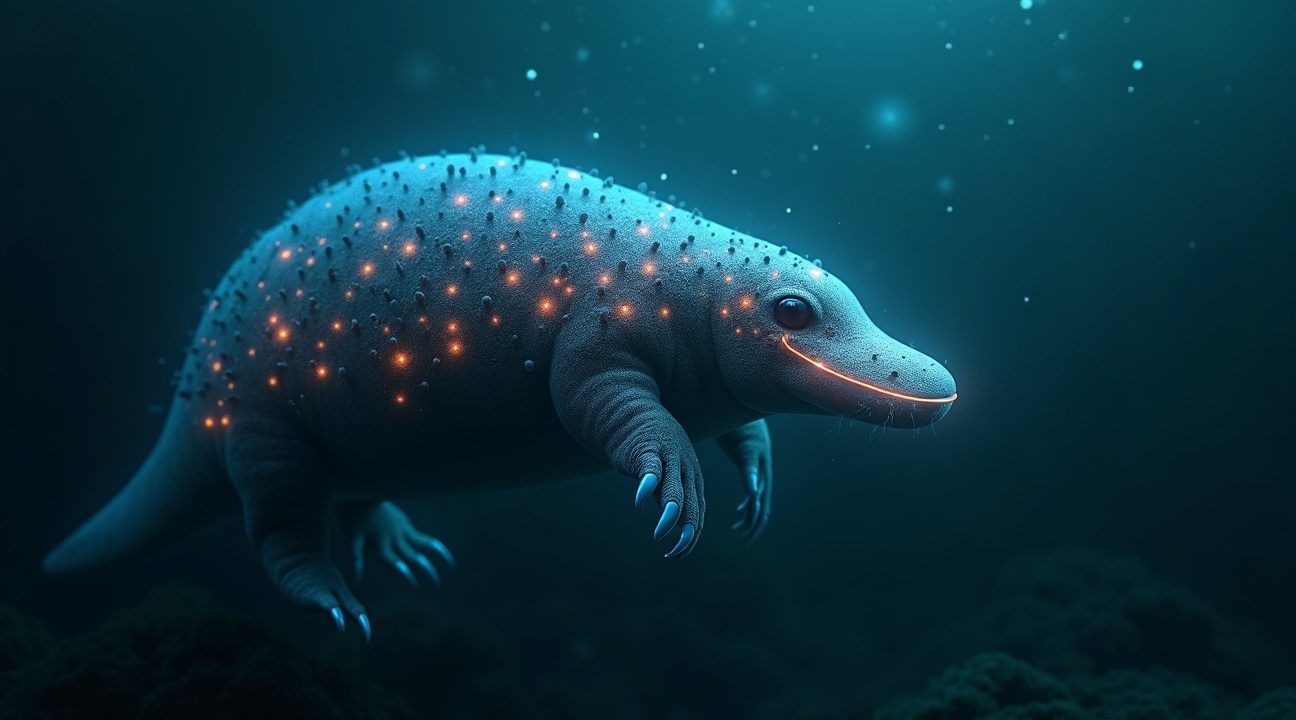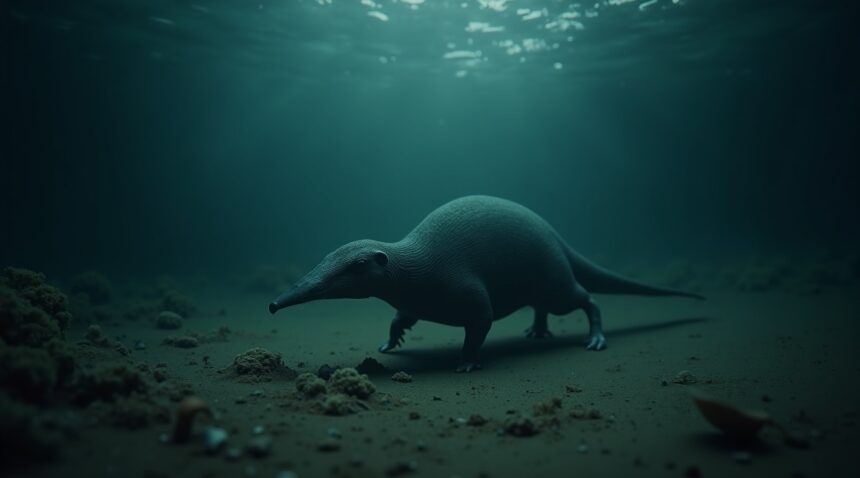The platypus has developed one of nature’s most remarkable hunting adaptations, swimming completely blind, deaf, and unable to smell while relying entirely on its bill’s electrical detection system to locate prey underwater.
With approximately 40,000 electroreceptors packed into its flexible bill, this extraordinary monotreme can detect the minute electrical signals generated by muscle contractions in hidden invertebrates, creating a three-dimensional hunting map in complete sensory isolation.
Key Takeaways
- The platypus seals its eyes, ears, and nostrils completely shut during underwater hunts, forcing it to depend entirely on electroreception through its bill.
- The bill contains 40,000 electroreceptors and 50,000–60,000 mechanoreceptors that work together to detect electrical signals and water movements from prey up to 50 centimeters away.
- This dual sensory system allows the platypus to create precise three-dimensional maps of prey location, enabling successful hunting in murky water where vision would be useless.
- The platypus uses a strategic head-sweeping technique underwater, moving its bill from side to side like a biological metal detector to maximize sensory coverage.
- Among all monotremes, the platypus possesses the most advanced electroreceptive system, with sensory capabilities that exceed those of its closest relatives, the echidnas, by up to 100 times.
Learn More About the Platypus
To explore more about the unique biology and adaptations of the platypus, visit the comprehensive article on the Wikipedia page about the platypus.
How a Platypus Hunts Completely Blind, Deaf, and Unable to Smell
When a platypus dives underwater to hunt, it seals off three of its most essential senses completely. The animal closes its eyes tightly, folds its ears shut, and clamps its nostrils closed before submerging. This remarkable adaptation prevents water from flooding these delicate sensory organs during extended underwater forays.
I find it fascinating that this creates a hunting scenario unlike any other in the animal kingdom. The platypus becomes effectively blind, deaf, and unable to smell while actively searching for food beneath the surface. This sensory shutdown might seem like a massive disadvantage, but it actually represents one of nature’s most ingenious solutions to underwater hunting challenges.
Complete Sensory Isolation Forces Unique Hunting Strategy
The platypus’s approach differs dramatically from other aquatic hunters that maintain at least one primary sense during underwater pursuits. Consider these comparisons:
- Seals rely heavily on their excellent underwater vision to spot fish and squid
- Otters use their keen eyesight and sensitive whiskers to locate shellfish and crustaceans
- Diving birds like cormorants depend on sharp vision to track schools of fish
- Whales and dolphins maintain their hearing abilities to use echolocation
This complete sensory isolation forces the platypus to depend entirely on its bill’s extraordinary electrical detection system. The animal must trust its electroreception abilities completely, swimming through murky river bottoms without any visual, auditory, or olfactory backup systems. I consider this one of the most extreme examples of sensory specialization in the natural world.
During hunting dives that can last up to two minutes, the platypus sweeps its bill from side to side like a metal detector. Every muscle contraction from a hidden shrimp, every gill movement from a small fish, and every tail flick from a freshwater crayfish generates minute electrical fields that the bill’s 40,000 electroreceptors can detect. The animal processes this electrical information instantly, creating a three-dimensional map of nearby prey without needing to see, hear, or smell anything.
This hunting method proves incredibly effective despite its apparent limitations. Platypuses can locate prey buried several centimeters deep in river sediment, something that would be impossible using vision alone in the murky waters they typically inhabit. The electrical signals penetrate through mud and debris that would completely obscure visual hunting methods.
The platypus’s commitment to this sensory shutdown demonstrates remarkable evolutionary confidence in its electroreception abilities. Unlike performers who rely on multiple senses, this mammal has placed all its hunting success on a single, highly specialized sensory system. The strategy works so well that platypuses can capture enough prey during their brief underwater excursions to meet their substantial caloric needs.
Water temperature and clarity don’t affect this hunting method the way they would impact vision-based predators. Whether diving in crystal-clear mountain streams or muddy lowland rivers, the platypus maintains the same hunting effectiveness. This consistency gives the animal a significant advantage over competitors that struggle in poor visibility conditions.
The platypus surfaces between dives to process and consume captured prey, then repeats the cycle of sealing its senses and diving back down. This rhythm of sensory shutdown and restoration continues throughout each hunting session, typically during dawn and dusk hours when the animal is most active.
Modern technology has attempted to replicate this sensory approach, but human-made underwater electrical detection systems remain far less sophisticated than the platypus’s natural abilities. Engineers studying this remarkable hunting method continue to develop new underwater sensing technologies inspired by the platypus’s unique approach to finding food in complete sensory isolation.

The Platypus’s Electric Sixth Sense Rivals Any Superhero Power
I find myself amazed by the platypus’s extraordinary hunting abilities. This unusual mammal possesses approximately 40,000 electroreceptors packed into its distinctive bill, creating one of nature’s most sensitive electrical detection systems. These specialized sensors surpass the capabilities of most other animals, establishing the platypus as a true marvel of evolutionary engineering.
How Electroreception Works in Platypuses
Each electroreceptor contains up to 30 different nerve endings, forming an intricate network that can detect voltages as low as 20 microvolts per centimeter. This sensitivity allows the platypus to pick up the tiny electrical signals generated by muscle contractions in prey animals. When insect larvae, shrimp, and small crustaceans move their muscles underwater, they create minute electrical fields that the platypus’s bill instantly detects.
The platypus’s electroreceptive system operates with remarkable sophistication compared to other species that possess this ability. While some fish and amphibians can sense electrical fields, the platypus has developed a more complex and specialized system that gives it a significant advantage in murky water environments. During hunting, the platypus closes its eyes, ears, and nostrils completely, relying entirely on this electrical detection system to locate food.
This electrical sensing ability functions like a biological GPS system. The platypus sweeps its bill from side to side as it swims along the bottom of rivers and streams, creating a detailed electrical map of its surroundings. The concentration of electroreceptors is highest at the tip of the bill, where sensitivity reaches its peak. Just as NASA scientists use sophisticated instruments to detect signals from space, the platypus uses its natural equipment to detect the faintest electrical signatures underwater.
The platypus processes this electrical information incredibly quickly, allowing it to strike at prey with pinpoint accuracy even in complete darkness or murky water. This adaptation proves particularly valuable in the platypus’s natural habitat, where visibility often remains poor due to sediment and vegetation. The electrical field detection works in conjunction with mechanical pressure sensors in the bill, creating a dual sensory system that makes the platypus an extraordinarily efficient underwater predator.
Dual Sensory System: 60,000 Touch Detectors Work Alongside Electric Sensors
I find the platypus’s bill fascinating because it houses an extraordinary collection of 50,000 to 60,000 mechanoreceptors called push rods that detect touch and water movement. These specialized sensors create a sophisticated detection network that complements the animal’s electrical sensing abilities, forming one of nature’s most advanced hunting systems.
Push rods demonstrate remarkable sensitivity, detecting water movement or pressure changes caused by prey actions from distances of 15-20 centimeters away. Under optimal conditions, these mechanoreceptors can even sense disturbances from up to 50 centimeters away. The system responds to various mechanical stimuli including pressure pulses moving through water and subtle movements in silt created by prey organisms.
Advanced Neural Processing Creates Precise Location Mapping
The true brilliance of this system lies in the platypus’s somatosensory cortex, where neurons processing tactile and electrical information are closely interwoven. This unique neural integration allows the animal to combine data from both sensory modalities simultaneously. Rather than processing these signals separately like complex space missions that rely on multiple independent sensors, the platypus brain creates a unified sensory map.
Three-Dimensional Prey Location Through Bill Sense
This integration enables the platypus to precisely locate prey in three-dimensional space through what researchers call bill sense. The animal’s brain creates detailed spatial maps by comparing the timing and intensity of signals from different parts of the bill. When a small crustacean moves in nearby sediment, push rods detect the mechanical disturbance while electroreceptors simultaneously pick up the creature’s bioelectric field.
The combined information allows the platypus to determine not just the prey’s location but also its size, movement direction, and distance with remarkable accuracy. This sophisticated sensory fusion explains how the animal can hunt successfully in murky water where visual cues become useless, much like how performers rely on multiple cues to navigate complex stage environments.
The platypus essentially creates a detailed three-dimensional model of its underwater environment using only its bill, transforming mechanical and electrical signals into precise hunting coordinates that guide successful prey capture.

Strategic Head-Sweeping Technique Pinpoints Prey Location
I find it fascinating how platypuses have mastered an underwater hunting strategy that relies entirely on their remarkable bill rather than traditional senses. When a platypus dives beneath the surface, it deliberately shuts its eyes, ears, and nostrils, transforming into a living electrical detector that sweeps methodically across the riverbed.
The sweeping motion isn’t random—it’s a calculated technique that maximizes the bill’s sensory capabilities. As the platypus moves its head from side to side, different strips of mechanoreceptors and electroreceptors along the bill take turns collecting information. This alternating detection pattern enhances signal separation, making it easier to distinguish between various electrical signatures in the water.
Advanced Sensory Detection Methods
The strategic sweeping allows platypuses to process multiple types of sensory data simultaneously. The bill contains thousands of specialized receptors that can detect:
- Electrical fields generated by muscle contractions in prey animals
- Mechanical vibrations from moving invertebrates
- Pressure changes caused by swimming crustaceans
- Subtle water displacement from insect larvae
This comprehensive sensory approach proves incredibly effective, even in challenging conditions. Scientists have demonstrated that a platypus can consistently locate a hidden electrical source, such as detecting a battery beneath rocks. The accuracy of this system allows these remarkable creatures to thrive in murky, turbid water where visual hunting would be impossible.
During their nocturnal foraging sessions, platypuses can consume up to half their body weight in food per night. They systematically sweep their bills across river bottoms, searching for bottom-dwelling invertebrates, crustaceans, and insect larvae. The methodical nature of their hunting technique ensures they don’t miss potential meals while conserving energy underwater.
I’m particularly impressed by how this hunting strategy enables platypuses to forage successfully in complete darkness. Unlike many aquatic predators that rely on vision or echolocation, platypuses have evolved to use bioelectricity as their primary hunting tool. This adaptation gives them a significant advantage in murky Australian waterways where visibility is often limited. Much like how NASA scientists find complex systems in unexpected places, nature has equipped the platypus with an extraordinary sensory system that continues to amaze researchers studying their unique hunting abilities.
Ancient Monotreme Evolution Created Nature’s Most Advanced Electric Hunter
The platypus stands alone among Earth’s mammals as a living testament to ancient evolutionary innovation. This remarkable creature belongs to an exclusive group of only five monotreme species, yet it has developed the most sophisticated electroreceptive system of any mammal on the planet. While its closest relatives, the echidnas, possess between 400 and 2,000 electroreceptors, they pale in comparison to the platypus’s extraordinary sensory capabilities.
The Revolutionary Bill Design
I find it fascinating that many people mistake the platypus bill for something similar to a duck’s appendage, but this comparison couldn’t be further from the truth. The platypus bill feels soft and pliable, with a texture resembling suede leather rather than the hard, rigid structure found on waterfowl. This flexible design houses an incredible array of sensory organs that work together to create what scientists consider nature’s most advanced biological detection system.
The bill’s unique construction allows the platypus to process multiple types of sensory information simultaneously. Unlike the simplified structures found in other aquatic mammals, this organ represents millions of years of evolutionary refinement specifically adapted for underwater hunting. The soft tissue can bend and flex as the animal probes riverbed sediments, while maintaining the sensitivity needed to detect the faintest electrical signals from hidden prey.
Evolutionary Pressures Shape Perfect Adaptation
Australia’s murky streams and rivers created the perfect environmental pressure for developing these remarkable adaptations. The platypus evolved to hunt during nighttime hours when visibility drops to near zero, making traditional sight-based hunting impossible. These challenging conditions pushed the species to develop sensory capabilities that surpass even the most sophisticated scientific instruments humans have created for underwater detection.
The nocturnal, aquatic lifestyle demanded a complete sensory revolution. Swimming with eyes, ears, and nose sealed shut, the platypus relies entirely on its bill’s electroreceptive abilities to locate food sources. This adaptation represents one of evolution’s most successful solutions to environmental challenges, creating a predator perfectly suited to its unique ecological niche.
These specialized features set the platypus apart not only from all other mammals but also from its fellow monotremes. While echidnas retained more generalized sensory systems suitable for terrestrial living, the platypus took a dramatically different evolutionary path. The result is a creature that seems almost alien in its capabilities, demonstrating how environmental pressures can drive the development of truly extraordinary biological solutions.
Sources:
platypus.asn.au
The University of Western Australia
Illinois Valley Community College
Nature
American Museum of Natural History
National University of Singapore
PubMed


